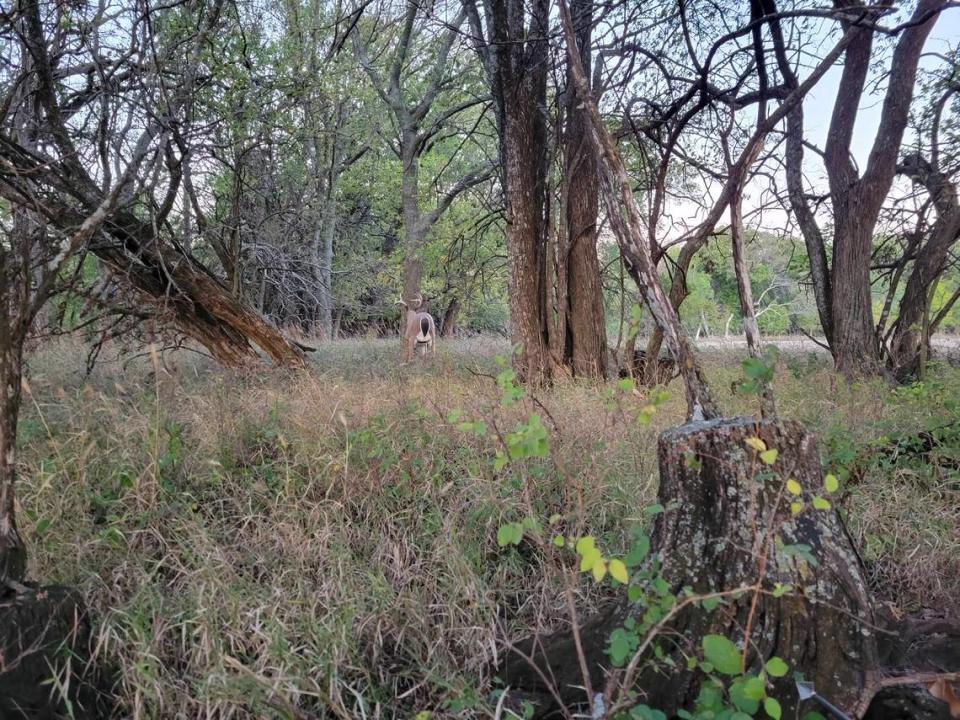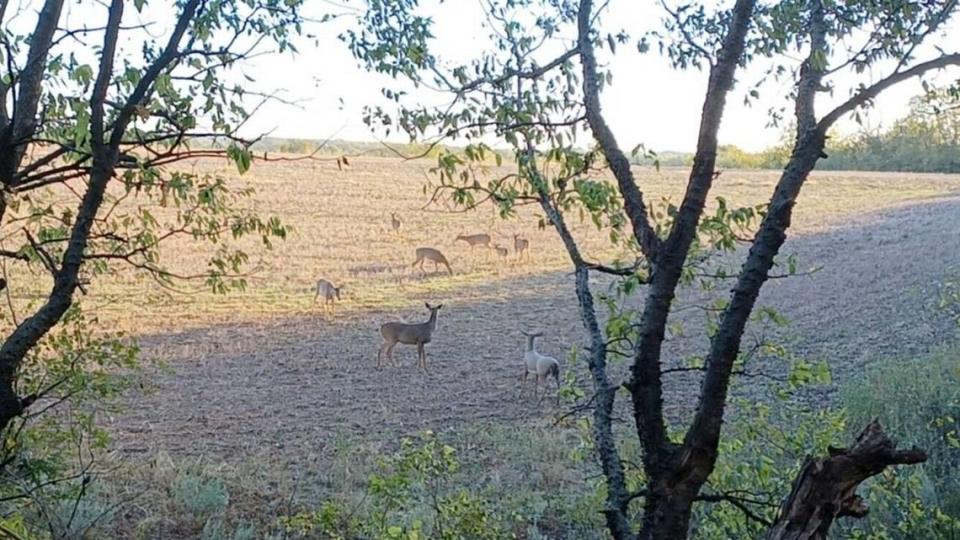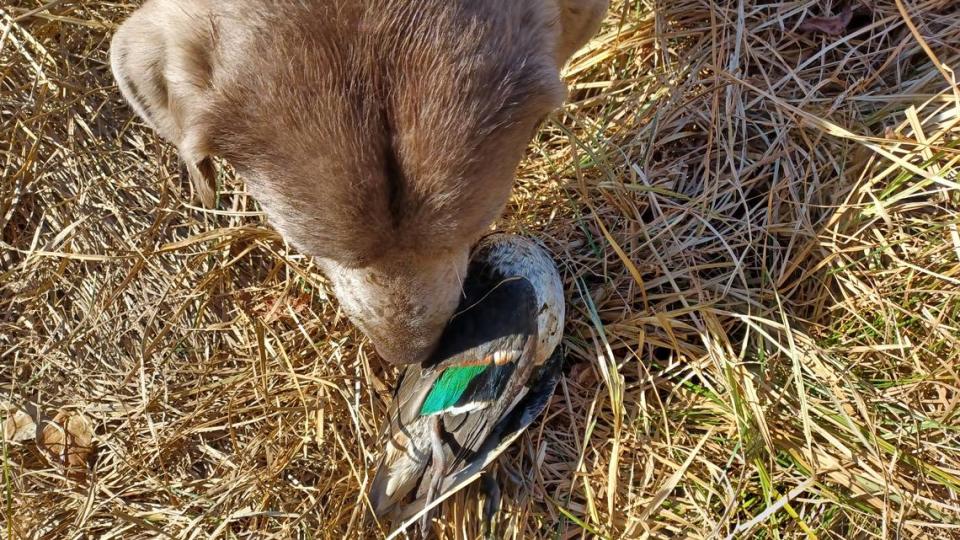As we head into fall in Kansas, it’s probably time to think about deer decoys
Kansas is roughly two weeks out from the start of the rut, and deer are starting to break from their summer and early-fall patterns.
The buck of a lifetime could walk by at any moment — or maybe you’re trying to fill the freezer with an early-season doe.
Either way, one tool many hunters turn to at this time of year is a full-body deer decoy.
Eagle reporters Chance Swaim, who has used decoys for several years, and Michael Stavola, who is new to decoys, have some thoughts and advice for anyone thinking of giving deer decoys a try.
Fumbling into the deer season with a decoy
Sometimes I wonder if a buck looks at me and thinks, “Look at this idiot.”
I had some moments like that on my first hunt of the season, but it was still a good learning experience.
I decided to use my decoy for the third time since buying it two years ago. One of those other times drew a nice buck right in, but I anticipated he would continue on his path and not redirect to the decoy, so I was facing the wrong direction and never got a shot off.
So, I was walking in with my decoy this week. I didn’t like the strap that came with it so I made my own, but that didn’t work out well. I dropped the head about six times before I tucked it under my arm and forged on.
I decided to go along the tree row near the corner of the property I hunt and set up on the ground. I have a couple stands in the wooded area of the property but had an interest in sitting in this spot. The neighboring properties that converge there have some thick woods that hold a lot of deer.
I set up the decoy and realized I lost an ear on my way in. I found it on my way out.

I saw about a dozen doe during the sit and one nice buck on the neighboring property. Two doe came within four yards of me. It’s the closest I’ve ever had deer come to me while on the ground without bolting, and I think I know why.
Obviously, the wind was in my favor.
But I also had the sunrise behind me. The family friend whose property I hunt on told me he likes hanging stands where deer will have to look into the sun toward him. Wind direction is always my No. 1 consideration, but maybe sun direction should be something I consider, too. The deer definitely knew something wasn’t quite right, but they foraged a little bit before trotting off. They didn’t huff and stomp at me (though another doe later did) like I would have expected. What’s your thoughts and experience on having the sun behind you?
Other takeaways from the sit:
Deer are either curious or indifferent about my decoy. Hang a blind and that first day the deer that pass it will be on edge. The decoy doesn’t have that effect.
The buck I saw stayed behind some bushes while the doe foraged in the field. He then walked off in their direction after they moved on. It looked to me like he was keeping tabs on them, like he knew they would soon be in estrus and wanted to be close by when they were.
— Michael Stavola
A true believer in decoys
I’ve used deer decoys for several years now, and I’m a true believer that they can and do draw deer, including mature bucks, within bow range.
A little background: Before I started bowhunting Kansas white-tailed deer, I spent a lot of time hunting waterfowl. I’ve also done a fair bit of turkey hunting. From those experiences, I learned how important calls and decoys can be to a successful hunt — and how much thought and skill goes into decoy placement and calling techniques. You also learn more about the animals you’re hunting as you try to learn their language.
So obviously I had to try to master calling and decoying deer. What I’ve learned is that big bucks and mature does — like late-season mallards — are usually more wary of decoys than young deer. (You’ll see why I wrote “usually” below.)
I wouldn’t consider myself a master at this point. But I have shot multiple bucks — and passed on dozens more — hunting over a doe decoy. Don’t be afraid to pair your decoy with calling and rattling, especially in late October.

Here are a few of the lessons I’ve learned:
Don’t put your decoy out too early: One of my first times out with a doe decoy, a massive buck wasted no time making a move. In a matter of fifteen seconds, he walked out of the woods, sniffed the decoy and mounted it in the field 20 yards in front of me.
It was about an hour before shooting time, so I couldn’t tell you exactly how big his rack was. The outline of his body was huge.
What happens when a buck likes your decoy a little too much and it’s before legal shooting time? The buck tries to mount it, knocks the hollow plastic shell to the ground and takes off like he was shot out of a cannon. In the aftermath, you have to climb down and set the decoy back up, wondering whether you’ll ever see that deer again.
Point it away from you: My deer decoy (a Flambeau “Boss Babe”) is standing still and staring at a fixed object. When other deer approach, often their first instinct is to see what the decoy is staring at.
If you place your decoy facing you, a smart deer will stand behind it scoping the woods until it finds you, even if you’re in a tree stand. Don’t do it.
I’ve also noticed many deer will approach a decoy head-on, so I don’t like to sit directly in line with the decoy’s sight-line.
Instead, face your decoy away from you, but not straight away. I prefer my decoy to be standing broadside or quartering away. Mind the wind. I set my decoy at a distance where I’m comfortable shooting a deer if approaches from either side of the decoy. Fifteen to 20 yards is pretty safe. If you don’t have a rangefinder, a decoy can be a good way to mark a distance.
The wind will knock it over: This is Kansas. It gets windy. When a decoy tips over, it’s loud, and deer don’t like it. Avoid this situation whenever you can. I’ve had some success keeping my decoy in place by putting a heavy log inside the body cavity to weigh it down.
Decoys are heavy, cutouts aren’t: Deer decoys are not fun to carry, especially if you’re already carrying your bow, a set of rattling antlers and a backpack. They’re heavy and loud.
If you’re walking a long distance or hunting public land where you can’t keep your decoy stashed below your stand when you’re not using it, I would suggest trying a much lighter-weight 2-D cutout decoy. I’ve never used them, but some guys swear by ‘em. I’m sure they have their own set of unique limitations. (Give me a holler if you’ve used cutout decoys).
— Chance Swaim
Other hunting
Duck numbers don’t look great for the upcoming youth season in the Low Plains Late Zone. This week, Swaim shot his first duck of the season: a green-winged teal that flew in with a group of eight. It was the only group he saw. Dove numbers are dwindling. Pheasant and quail numbers appear healthy in south-central Kansas.

P.S. Thank you to everyone who sent us feedback on deer baiting. We’re still gathering information and opinions, so please write us at cswaim@wichitaeagle.com and mstavola@wichitaeagle.com.
Send us photos from your hunt, too. Contact Swaim or Stavola for instructions.
If you’d like to have our free Open Season newsletter emailed to your inbox, you can sign up here.


